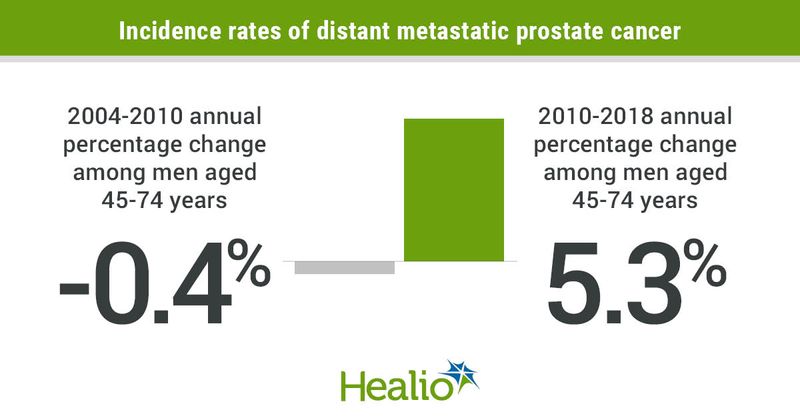Rise in metastatic prostate cancer incidence coincides with screening guideline changes
Increases in metastatic prostate cancer incidence may be temporally associated with changes in clinical policy following U.S. Preventive Services Task Force recommendations, according to a study in JAMA Network Open.
“This study is the first to document a continued rise in metastatic prostate cancer using the most up-to-date population data set. Our study of the recently released 2004-2018 SEER data set confirms a rising incidence rate of metastatic prostate cancer coinciding with the 2008 and 2012 USPSTF recommendations against PSA-based prostate cancer screening,” Giovanni E. Cacciamani, MSc, MD, assistant professor of research urology at Keck School of Medicine of University of Southern California, told Healio.

Background and methodology
In 2012, the USPSTF recommended against routine PSA-based prostate cancer screening for all men. In 2008, it made the same recommendations for men aged older than 75 years.
Cacciamani and colleagues said concern followed that the recommendation could contribute to an increase in the incidence of metastatic prostate cancer. To evaluate the potential impact, they investigated metastatic prostate cancer incidence before and after the USPSTF recommendations against routine screening.
The analysis included 836,282 men with prostate cancer recorded in the SEER database from 2004 to 2018.
Desai and colleagues examined annual age-adjusted incidence rates per 100,000 men with prostate cancer according to race and age, adjusting for age structure and reporting delay from 2004 to 2011. Then they calculated the annual percentage changes (APCs) to quantify the changes in annual incidence rates.
Key findings
Results showed 26,642 (56.5%) of the distant metastatic prostate cancer cases occurred in men aged 45 to 74 years and 20,507 (43.5%) in men aged 75 years or older.
Desai and colleagues found that, among men aged 45 to 74 years, the incidence rate of distant metastatic prostate cancer (SEER Summary staging) remained stable from 2004 to 2010 (APC, 0.4%; 95% CI, 1.7 to 1.1) but increased significantly during 2010 to 2018 (APC, 5.3%; 95% CI, 4.5-6).
Among men aged 75 years or older, the incidence rate of distant metastatic prostate cancer decreased from 2004 to 2011 (APC, 1.5%; 95% CI, 3 to 0) before increasing from 2011 to 2018 (APC, 6.5%; 95% CI, 5.1-7.8). Additionally, researchers found particularly significant increased trends in incidence among non-Hispanic white men (2010-2018 APC, 6.9%; 95% CI, 5.4-8.4).
“The increased metastatic prostate cancer incidence rates occurred despite a significant concurrent reduction in the overall incidence of prostate cancer diagnosis,” Cacciamani said. “Since SEER cannot provide data to assess causality, this trend should be carefully studied further to see if it continues beyond 2018 and whether it is associated with a similar rise in prostate cancer mortality.”
Implications
Cacciamani noted the stark contrast between the increased incidence rates observed in the study and the decreases prior to the USPSTF recommendations.

“Although the reasons behind this recent rising incidence are multifactorial, it is unlikely to be due to a true change in cancer biology in such a short period of time. Factors such as environmental exposures or germline mutations leading to changes in epidemiologic signatures of cancers take significantly longer,” Cacciamani said. “Rather, changes in clinical policy and/or practice such as screening strategies and use of diagnostic imaging are much more likely to explain such relatively short-term swings in cancer epidemiologic trends.”
An accompanying editorial also examined the relationship between screening practices and guidelines and prostate cancer incidence, emphasizing the need to strike a balance between early detection and overtreatment.
“Less screening reduces the risks [for] overdiagnosis and overtreatment, but there is a trade-off,” wrote Richard M. Hoffman, MD, MPH, professor of internal medicine, director in the division of general internal medicine, and co-leader of the cancer epidemiology population science program at Carver College of Medicine and University of Iowa Health Care.
“The harms of overtreatment could be mitigated if men with low-risk prostate cancer routinely engage in shared decision-making around treatment choices and are supported in considering active surveillance,” Hoffman concluded. “Although the overall number of cancer diagnoses might not rebound to the level seen before the guideline change, the number of men discussing screening and receiving diagnoses of clinically important treatable cancers could increase. Achieving these outcomes might further reduce morbidity and mortality from prostate cancer, reversing recent metastatic prostate cancer trends and minimizing the harms of overdiagnosis and overtreatment.”
References:
Desai MM, et al. JAMA Netw Open. 2022;doi:10.1001/jamanetworkopen.2022.2246.
Hoffman RM. JAMA Netw Open. 2022;doi:10.1001/jamanetworkopen.2022.2174.
For more information:
Giovanni E. Cacciamani, MSc, MD, can be reached at Urology Institute, Keck School of Medicine, 1441 Eastlake Ave., Suite 7416, Los Angeles, CA 90089-9178; email: giovanni.cacciamani@med.usc.edu.
